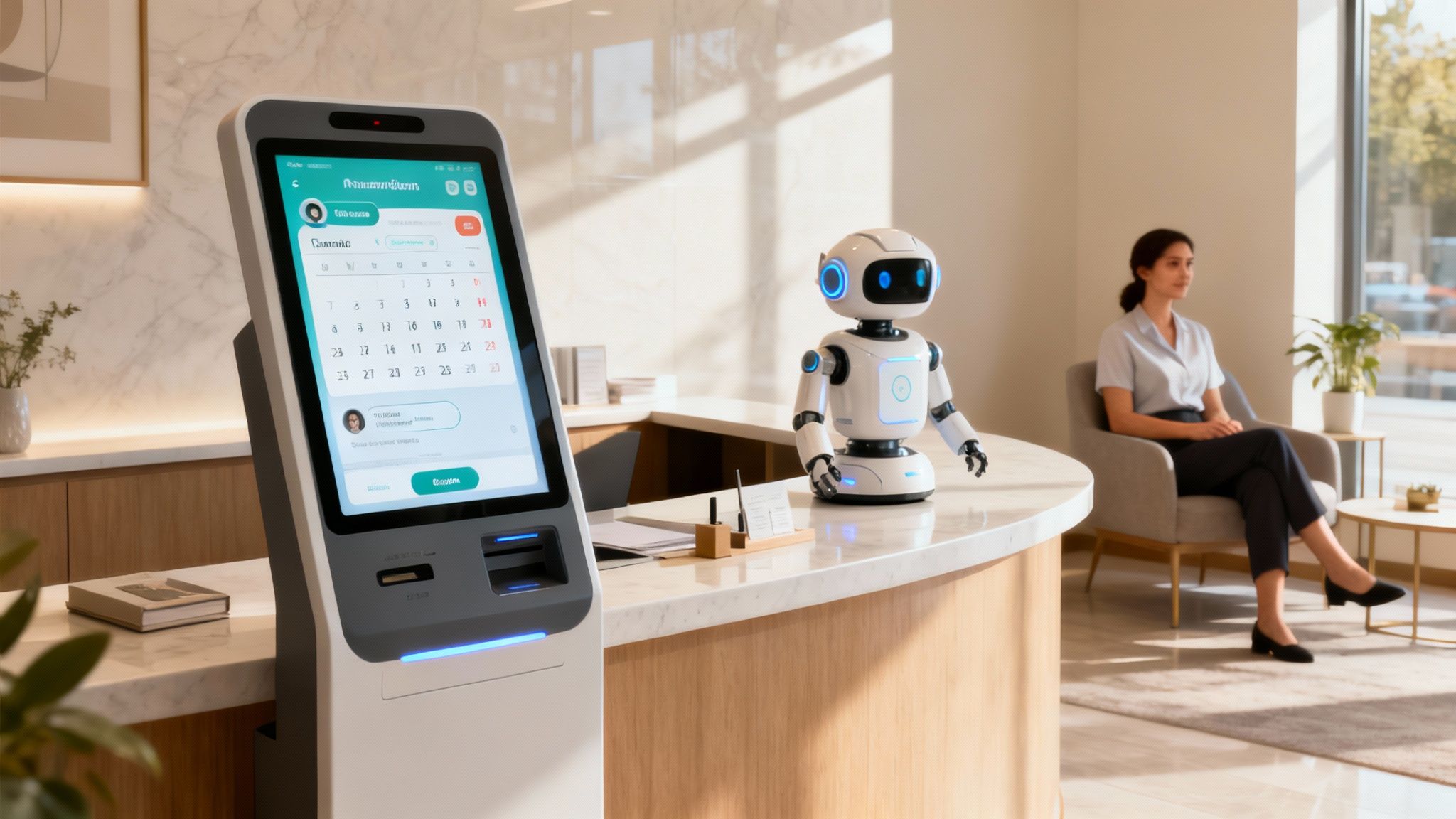When people talk about using AI in healthcare, it's not about futuristic robots taking over. It's about practical tools we can use right now to automate tedious administrative work, sharpen diagnostic accuracy, and ultimately give clinicians more time to spend with their patients. These advancements are not distant dreams but tangible solutions reshaping the landscape of modern medicine.
Think of it as a powerful assistant that enhances, not replaces, the skills of your dedicated healthcare team. By taking on the repetitive, data-intensive tasks, AI empowers medical professionals to focus on the nuanced, human elements of care, strengthening the patient-provider relationship.
The Reality of AI in Modern Healthcare

Let's cut through the hype. AI in healthcare isn't a sci-fi concept anymore; it's intelligent software being applied today to solve the persistent challenges we see in clinics and hospitals every single day. From managing patient flow to assisting in complex surgical procedures, AI's integration is becoming increasingly widespread and vital.
The real purpose here is to augment human expertise. AI is fantastic at churning through massive amounts of data, spotting patterns a person might overlook, and doing repetitive tasks flawlessly. This frees up doctors, nurses, and staff to focus on what they do best: providing thoughtful, compassionate care to patients. The technology acts as a force multiplier for a clinician's skills, leading to better outcomes and a more sustainable healthcare system.
Freeing Up Clinical and Administrative Staff
One of the first places you'll feel the impact is in tackling the mountain of administrative work. Tasks like scheduling, medical coding, and wrestling with electronic health records (EHR) eat up an incredible amount of time and are a huge factor in staff burnout. This administrative burden detracts from the core mission of healthcare: patient well-being.
AI-powered systems can take on these jobs with remarkable efficiency. For example, smart voice agents can handle patient intake calls and book appointments 24/7. This means no missed calls and a front desk that can give its full attention to the patients standing right in front of them. For a deeper look at the current landscape, this AI in Healthcare industry overview offers some great insights into how various technologies are being deployed across the sector.
The core value of AI in a clinical setting is its ability to create time. By automating routine work, it gives back precious minutes and hours to doctors, nurses, and administrators—time that can be reinvested directly into patient interaction and complex decision-making.
The financial upside is just as compelling. Some experts project that AI could save the U.S. healthcare system as much as $150 billion annually by 2026, simply by making processes more efficient and cutting down on administrative waste. This isn't just about cost-cutting; it's about reallocating resources to where they matter most—direct patient care and innovative treatments.
To see where this technology makes the biggest difference right away, here's a quick breakdown.
Key Areas Where AI Delivers Immediate Value
| Healthcare Domain | Primary AI Application | Key Benefit |
|---|---|---|
| Administrative Tasks | Automated Scheduling & Billing | Reduces staff workload and minimizes errors. |
| Patient Communication | 24/7 AI Voice Agents & Chatbots | Improves patient access and satisfaction. |
| Diagnostic Imaging | Image Analysis (X-ray, MRI) | Enhances accuracy and speeds up review time. |
| Clinical Documentation | Voice-to-Text Scribing | Frees clinicians from manual data entry. |
| Population Health | Predictive Analytics | Identifies at-risk patients for early intervention. |
| Drug Discovery | Analyzing Molecular Structures | Accelerates research and development timelines. |
| Surgical Assistance | Robotic Precision & Guidance | Improves surgical outcomes and reduces recovery time. |
This table highlights just a few of the high-impact areas where AI can be deployed quickly to solve real-world problems facing most practices, from small clinics to large hospital networks.
Enhancing Diagnostic and Clinical Capabilities
Beyond the front office, AI is also making a real difference in clinical work. Machine learning algorithms can analyze medical images, like X-rays and MRIs, and flag subtle anomalies for a radiologist to review. It's like having a second set of expert eyes on every scan, which can boost both accuracy and speed. This collaborative approach between human experts and AI is setting a new standard for diagnostic precision.
Predictive analytics is another game-changer. By sifting through patient data, AI can help identify individuals at high risk for developing certain conditions, paving the way for proactive, preventive care. This shift from reactive to preventive medicine is one of the most profound impacts of using AI in healthcare.
These specialized AI agents are built for specific jobs, making it easier to implement them where you need them most. It's all about making healthcare smarter, more efficient, and more focused on the patient.
Finding Your Practice's AI Starting Point
Before you get caught up in the latest AI bells and whistles, let's get back to basics. The most important question isn't "What can this new tech do?" but rather, "What problem do I need to solve right now?" Diving into AI without a clear target is like prescribing medication without a diagnosis—it's a surefire way to waste time and money. A strategic, problem-focused approach is essential for success.
The secret to a successful AI rollout is starting small and specific. Take an honest look at your daily operations and pinpoint the exact bottlenecks and headaches that are slowing your practice down. Where are you losing time? What tasks frustrate your staff and patients the most? A clear-eyed audit of your workflows will show you exactly where an AI tool can make a real, immediate difference. This internal analysis forms the foundation of a successful implementation strategy.
First, Tackle Your Administrative Headaches
Let’s start with your administrative team—the backbone of your practice. They're often bogged down by a mountain of repetitive tasks that are essential but don't require a medical degree. In fact, a 2023 study confirmed that administrative work is one of the top areas where AI can make a huge impact on efficiency, freeing up human resources for higher-value activities.
Think about a typical day for your front-desk staff. Are they constantly playing phone tag to schedule appointments, handle refill requests, and answer billing questions? Every minute a patient spends on hold is a point of friction, and every piece of information entered by hand is a chance for error. These small inefficiencies accumulate, leading to significant operational drag and diminished patient satisfaction.
A great way to find these pain points is to walk through the entire patient journey, from their first phone call to their follow-up. Where do things get stuck?
- Getting in the Door: How long are patients waiting on hold to book a visit? How much revenue are you losing from calls missed after hours?
- The Check-In Shuffle: Is your team still manually typing patient data from clipboards into the EHR?
- Coding and Billing: How much time does it take to turn a doctor's notes into the right medical codes for a claim?
- Patient Reminders: Are your staff members making dozens of manual calls for appointment confirmations or post-op instructions?
Each one of these is a perfect opportunity for AI. An AI-powered voice agent, for example, could schedule appointments 24/7, which means no more hold music for patients and more time for your staff to help the people standing right in front of them. This not only enhances efficiency but also improves the overall patient experience.
Focus on your single biggest administrative time-sink. Solving that one problem first will give you a quick, tangible win. It proves the value of the technology and builds the confidence to tackle bigger challenges down the road.
Uncovering Clinical Workflow Inefficiencies
Beyond the front desk, AI can also smooth out major kinks in your clinical workflows. These are the issues that can directly affect patient care and contribute to clinician burnout. Are your doctors spending more time staring at a computer screen than making eye contact with their patients? Is your diagnostic team drowning in a backlog of images? These are critical questions to address.
Imagine a primary care clinic trying to keep up with follow-ups for patients with chronic conditions. It's almost impossible to manually track and call everyone who needs a check-in. This is where a tool like predictive analytics can be a game-changer, flagging patients at high risk for complications so your team can step in before a small issue becomes a big one. This proactive approach leads to better health outcomes and reduces the burden on the healthcare system.
Here are a few other real-world clinical scenarios where AI can help immediately:
- Clearing Diagnostic Bottlenecks: In a swamped radiology department, an AI algorithm can do a first pass on medical images, highlighting potential areas of concern. This helps radiologists prioritize their work, focusing on the most critical cases first and dramatically cutting down the time to diagnosis.
- Easing the Documentation Burden: A physician sees 20 patients and then spends another two hours at night catching up on notes. An ambient AI scribe can listen to the patient-doctor conversation and automatically draft the clinical note in the EHR. That's hours given back to the doctor for patient care—or to just go home on time.
- Reducing Readmission Risks: A hospital is struggling to lower its 30-day readmission rate for cardiac patients. AI models can analyze patient data—everything from lab results to past admissions—to predict who is most likely to end up back in the hospital. This allows the care team to create a truly personalized discharge and follow-up plan for those high-risk individuals.
- Optimizing Operating Room Scheduling: AI can analyze surgical schedules, surgeon availability, and equipment needs to create more efficient OR timetables. This reduces downtime, maximizes the use of expensive resources, and helps accommodate more patients in a timely manner.
Your ideal starting point lies at the intersection of a high-impact problem and a high-friction process. By zeroing in on a tangible issue first, you ensure your investment in AI delivers a clear and immediate return for your staff, your patients, and your practice's health.
How AI Can Tackle Your Administrative Workflows

If you're in healthcare, you know that administrative overload is one of the biggest sources of burnout and inefficiency. AI isn't about replacing your team; it’s about giving them smarter tools to handle the relentless clerical work that bogs them down. This strategic application of technology allows skilled professionals to work at the top of their licenses.
The sheer volume of paperwork, endless phone calls, and constant data entry is a huge drain on resources. By automating the most repetitive tasks, you can see an almost immediate improvement in your practice's daily flow and your team's morale. This creates a more positive and productive work environment for everyone.
Free Up Your Front Desk with Smart Scheduling and Communication
Let's be honest: the phone is a major bottleneck. Your front-desk staff spends a massive chunk of their day juggling appointment requests, handling cancellations, and answering the same patient questions over and over. This is a perfect job for AI.
AI-powered voice agents and chatbots can take on these conversations instantly, 24/7.
Think about a patient who needs to schedule a follow-up at 10 PM. Instead of leaving a voicemail and playing phone tag, they can chat with an AI agent that checks your schedule, finds an open slot, and books the appointment on the spot. It’s a better experience for them and ensures you’re not missing opportunities to fill your calendar. This enhanced accessibility is a key differentiator in a competitive healthcare market.
This same tech can also handle:
- Appointment Reminders: Sending out automated texts or calls to confirm appointments can slash your no-show rates.
- Prescription Refills: Patients can be guided through the refill process automatically, with the request landing in the right queue for clinical sign-off.
- Answering Basic Questions: The AI can field all those common questions about office hours, directions, and pre-procedure instructions, freeing up your team for more complex patient needs.
- Pre-registration and Intake: AI can gather necessary patient information and insurance details before the visit, streamlining the check-in process and reducing wait times.
The real win with using AI in healthcare administration is making things easier for everyone. When routine tasks are handled automatically, your staff can focus on what they do best: helping patients with complex issues, discussing financial options, and providing a warm, welcoming experience.
The market is certainly responding to this need. The AI in healthcare market blew past $20 billion in 2023 and is expected to grow by a staggering 40% each year through 2028. You can get a closer look at these numbers in a detailed market analysis from Grand View Research.
Cut Down on Clinical Documentation and EHR Headaches
The admin burden doesn't stop at the front desk. Physicians often lose hours every single day just typing notes into Electronic Health Records (EHRs), a major cause of burnout. This is where a type of AI called Natural Language Processing (NLP) can make a huge difference.
Tools with ambient listening, for example, can securely listen to a conversation between a doctor and patient and automatically draft a structured clinical note. The doctor just has to review it and sign off. We're talking about saving massive amounts of time. Voice-to-text transcription tools offer a similar benefit, letting clinicians simply dictate their notes and have the AI turn it into accurate text inside the EHR.
A great example of this is Nuance's Dragon Medical One, which lets doctors capture the patient's story simply by speaking.
The interface allows a clinician to dictate notes that appear directly in the patient's chart in real-time. This one change can literally give a doctor hours back each week. This reclaimed time can be spent on patient care, research, or simply achieving a better work-life balance.
Make Medical Coding and Billing More Accurate
Medical coding is another area that's complicated, prone to human error, and absolutely essential to your revenue. AI tools are getting incredibly good at analyzing a doctor's notes and suggesting the right ICD-10 and CPT codes. This dramatically cuts down on claim denials and gets you paid faster.
These AI systems learn from millions of clinical notes and their corresponding codes, so they can spot patterns a human might miss. The result is cleaner claims, fewer rejections, and a much healthier bottom line for your practice. By targeting these core administrative pain points, AI creates a clear path to a more efficient and sustainable operation. If you're curious about how all these systems can work together, our guide to healthcare workflow automation is a great next step.
Improving Diagnostics and Patient Outcomes with AI

Fixing the administrative side of things gives you an immediate efficiency win, but the real game-changer with using AI in healthcare is how it can directly sharpen clinical decisions. We're not just talking about scheduling software anymore. This is about giving clinicians a powerful co-pilot to help them see more, spot risks earlier, and build better care plans.
This is where AI steps out of the front office and into the exam room, working right alongside medical professionals to make a real difference in patient lives. The potential to enhance clinical judgment and improve patient safety is immense.
Sharpening the Diagnostic Eye with AI
Medical imaging is one of the clearest examples of where AI is already making its mark. Think about it: radiologists, pathologists, and dermatologists spend their days searching for tiny, often subtle, clues in a vast sea of visual information. It’s an incredibly demanding job where focus is everything.
AI algorithms, trained on millions of past scans, can review X-rays, MRIs, and CT scans in seconds. They serve as a second set of eyes, flagging areas of concern that a human might miss, especially near the end of a long shift. This doesn't replace the expert; it backs them up, letting them zero in on the areas that truly need their attention. This synergy between human and machine leads to more reliable and timely diagnoses.
A great example is an AI tool that scans a chest X-ray and highlights a minuscule nodule that could be an early sign of lung cancer. By bringing that to the clinician’s attention right away, the path to a faster, more accurate diagnosis gets a lot shorter. Early detection is often the key to successful treatment, and AI is a powerful ally in this effort.
The real power of AI in diagnostics isn't about replacement, but augmentation. It processes visual data at a scale and speed we can't match, helping us catch diseases earlier and with more confidence.
Predicting Risk Before Crisis Strikes
Healthcare is finally shifting from being reactive to proactive, and predictive analytics is what's making it happen. By digging through mountains of data from electronic health records, AI can identify patients at high risk for serious problems long before the classic symptoms show up.
This is absolutely critical for conditions like sepsis, a life-threatening response to infection that can escalate incredibly fast and is notoriously hard to spot early.
AI models can keep a constant watch on a patient's vitals, lab results, and other data streams in real time. The system learns to recognize subtle patterns that signal the onset of sepsis and can alert the clinical team, kicking off an immediate intervention that can—and does—save lives. This real-time monitoring capability is a significant leap forward in patient safety.
We're seeing this predictive approach applied elsewhere, too:
- Identifying fall risks in older patients by analyzing their gait and balance data.
- Predicting cardiac events by finding hidden patterns in ECGs and patient histories.
- Forecasting flu outbreaks in a community by looking at symptom data from local clinics.
- Managing chronic diseases like diabetes by predicting hyperglycemic events based on continuous glucose monitoring data.
When you move from reaction to prediction, you can step in sooner with less invasive treatments, which leads to better outcomes and lower costs across the board.
Crafting Truly Personalized Treatment Plans
"Precision medicine"—the idea of tailoring treatment to a person's unique genes, lifestyle, and environment—used to feel like science fiction. AI is making it a practical reality by helping doctors make sense of incredibly complex personal data. This allows for care that is not one-size-fits-all, but uniquely suited to the individual.
In oncology, for example, AI tools can analyze a patient’s genomic data to recommend the most effective chemotherapy for their specific tumor. This helps avoid the brutal trial-and-error approach, sparing patients from treatments that aren't likely to work and come with punishing side effects. The growth here is explosive; in 2022, the FDA approved 521 AI-based medical devices, a massive jump from fewer than 50 back in 2010. You can read more about the FDA's stance on AI-enabled medical devices to see the data for yourself.
This kind of personalization is also changing chronic disease management. An AI-powered app for a diabetic patient can analyze their glucose levels, diet, and activity to give real-time advice on insulin dosage or what to eat next. It empowers people to become active partners in their own health.
From spotting disease to tailoring treatment, a thoughtful approach to AI is setting a new standard of care—one that is more data-driven, proactive, and perfectly tuned to the needs of each patient.
Choosing the Right AI Vendor for Your Practice

Bringing an AI solution into your practice isn't just a transaction; it's a partnership. The vendor you choose will become a critical part of your operational future, so getting this decision right is essential for a smooth transition and, ultimately, a solid return on your investment.
You need to look past the slick demos and flashy feature lists. Your focus should be on finding a partner who genuinely gets the unique pressures and complex regulations of healthcare. This choice will have a direct ripple effect on your staff's day-to-day work, your patients' data security, and your practice's bottom line. A diligent vetting process is not just recommended; it's mandatory.
Vetting Potential Partners: What to Ask
When you start talking to potential AI vendors, your initial conversations should zero in on a few non-negotiable areas. This is where you get down to brass tacks and see how their technology holds up in a real clinical environment.
First up, and most importantly: compliance.
The vendor absolutely must have an ironclad commitment to data security. Don't be shy about asking pointed questions about their HIPAA compliance, their data encryption methods, and exactly how and where they store patient information. Understanding the importance of robust cybersecurity for growing businesses is table stakes for any modern practice, especially when you're adding new tech to the mix. For a more detailed look, our guide on HIPAA-compliant AI tools is a great resource.
A vendor’s fluency in healthcare regulations is a direct indicator of their suitability. If they can't speak confidently about HIPAA, Business Associate Agreements (BAAs), and data security audits, they are not the right partner for a medical practice.
Beyond security, you need to know how their tool will play with your existing tech. Seamless integration with your Electronic Health Record (EHR) system is a must-have. Without it, you risk creating frustrating data silos and clunky manual workarounds for your team. Ask for a live demonstration of the integration with your specific EHR to verify their claims.
Vendor Vetting Checklist for AI Healthcare Solutions
To keep your evaluation process organized and ensure you cover all your bases, I recommend using a checklist. This simple tool helps you compare vendors apples-to-apples before making a final decision.
| Evaluation Criteria | Key Questions to Ask | Why It Matters |
|---|---|---|
| HIPAA Compliance | Can you provide your HIPAA compliance documentation and are you willing to sign a BAA? | This is a legal and ethical requirement to protect patient data. There is no room for compromise here. |
| EHR Integration | How does your system integrate with our specific EHR? Can we see a live demo of this integration? | Poor integration creates more work for your staff, defeating the purpose of adopting AI for efficiency. |
| Technical Support | What are your support hours? What is the typical response time for a critical issue? | When technology fails, you need responsive and knowledgeable support to minimize disruption to patient care. |
| Implementation & Training | What does your onboarding process look like? What training resources do you provide for our staff? | A great tool is useless if your team doesn't know how to use it confidently. Proper training is key to adoption. |
| Proven Results | Can you share case studies or connect us with a current client in a similar practice? | This provides real-world proof that the vendor can deliver on their promises and understand your specific challenges. |
| Scalability & Future-Proofing | How does your solution scale? What is your product roadmap for the next 1-2 years? | Your chosen solution should be able to grow with your practice and adapt to future technological advancements. |
Taking the time to ask these questions upfront will save you from major headaches down the road and ensure you find a partner who is truly invested in your success.
Planning a Phased and Successful Rollout
Even after you've found the perfect vendor, resist the urge to go all-in at once. The smartest way to bring AI into a healthcare setting is to start small with a controlled pilot program. This gives you a chance to test-drive the technology in a real-world setting without disrupting your entire practice.
Pick one specific workflow to start with—maybe appointment scheduling for a single department. Implement the AI tool there first. This creates a low-risk environment where you can get honest feedback from your staff and spot any unexpected hiccups. This initial phase is crucial for building internal support and demonstrating value quickly.
The pilot program is all about learning. You can iron out the kinks, fine-tune your training guides, and identify a few team members who can become champions for the new system. Once the pilot is a clear success and your team feels comfortable, you can then begin to strategically expand the AI solution to other departments. This measured, step-by-step approach is the key to a smooth transition and long-term success.
Got Questions About AI in Healthcare? We've Got Answers.
Bringing any new technology into a medical practice is a big decision, and it’s only natural to have a few questions. When it comes to AI, it’s smart to be thorough. Getting straight answers to the common concerns physicians, nurses, and administrators share is the best way to move forward with confidence.
Let's tackle some of the most frequent questions we hear from practices just like yours.
"Will AI Replace Our Doctors and Nurses?"
This is probably the most common question, and the answer is a resounding no. The goal of AI in a clinical setting isn't replacement; it's support.
Think of AI as an incredibly efficient assistant—one that’s great at handling the repetitive, data-heavy tasks that can bog down your day. It’s here to free up your skilled professionals to focus on the irreplaceable, human side of medicine: things like complex diagnoses, building patient trust, and providing compassionate care. The empathy, critical thinking, and ethical judgment of a human clinician cannot be replicated by an algorithm.
An AI can sift through thousands of charts to flag potential follow-ups, but it takes a clinician to understand the full context of a patient's life and health to make the right call. The technology makes great providers even better.
"How Can We Be Sure Our Patient Data Is Secure?"
Patient data security is non-negotiable, and that principle holds true with AI. Any reputable AI vendor in the medical space is legally bound to comply with strict regulations like HIPAA. In fact, a potential partner's commitment to security should be at the very top of your checklist.
When evaluating any AI tool, you need to dig into their security protocols. Here’s what to look for:
- End-to-end encryption to protect data whether it’s stored or being sent.
- Data anonymization so that any information used to train AI models has all personal identifiers stripped away.
- Strict access controls to ensure only authorized staff can see sensitive information, backed by a clear audit trail.
- Regular security audits and third-party certifications (like SOC 2) that validate their security posture.
Make a thorough security review a standard part of your vetting process. It's a foundational step in protecting your patients and your practice.
"What's the Biggest Hurdle to Getting Started?"
Surprisingly, it’s rarely the technology itself. The biggest challenge is almost always change management. Your team has established workflows they rely on, and introducing a new system can feel disruptive, no matter how much better it is. Overcoming this inertia requires a thoughtful and inclusive approach.
A successful rollout really comes down to the people. It takes clear communication from leadership explaining why this change is happening and how it will genuinely help both staff and patients. You also need solid training to build everyone's confidence with the new tools.
From my experience, the most effective AI implementations happen when clinicians are part of the conversation from day one. When your team feels a sense of ownership over the process, they become advocates for its success.
Starting with a small, focused pilot program is a great strategy. It lets people adapt at a more comfortable pace and proves the AI's value in a controlled way, which builds momentum for a broader rollout.
"Can a Smaller Clinic Realistically Afford AI?"
This is a huge misconception. While the first wave of AI systems required a massive upfront investment, that’s no longer the case. Today, many of the best AI solutions are offered as a Software as a Service (SaaS) subscription.
This model makes powerful tools accessible to practices of all sizes without the need for a huge capital expense. You simply pay a monthly or annual fee based on your usage, allowing you to start small and scale up as you grow. This democratizes access to advanced technology that was once only available to large hospital systems.
The key for smaller clinics is to pick one specific, high-impact problem to solve first. Don’t try to do everything at once. Maybe you target appointment scheduling or patient intake—an area where you can see a clear and quick return on your investment. The money and time you save there can fund the next step in your AI journey. You absolutely don’t need a giant hospital's budget to get started.
Ready to see how a clinically-trained AI can free up your staff and improve patient satisfaction? Simbie AI handles routine administrative tasks around the clock, from scheduling appointments to managing prescription refills, so your team can focus on what matters most—delivering excellent care. Discover how practices are cutting administrative costs by up to 60% by visiting the Simbie AI website.

